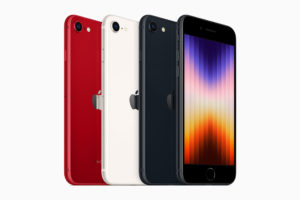
Apple has unveiled its newest mobile devices, and a pattern is taking shape: the company is sticking with fingerprint recognition for its second-tier offerings, and with facial recognition for its most premium devices.
Both the new iPhone SE and the iPad Air use Touch ID for biometric authentication, and not the 3D facial recognition system found in Apple’s recent flagship devices. And it’s fair to speculate that the decision to opt for fingerprint recognition is a matter of cost, first and foremost, as well as a response to demand.
3D is Expensive
The new iPhone SE illustrates the point pretty well. On its own promotional page for the new smartphone, Apple highlights the return of “The Home button you know and love,” immediately proceeding to note that “Touch ID is a fast, simple, and secure way to unlock your phone and sign into apps.”
That’s all true enough, but when Apple first unveiled its Face ID system in late 2017, the company made much of its improved accuracy in comparison to Touch ID. The technologies and production processes underlying both systems have undoubtedly changed in the ensuing years, but assuming that there is still a gap in performance between Face ID and Touch ID, it is likely still offset by the difference in cost. Because it requires sophisticated vertical-cavity surface-emitting laser (VCSEL) technology in order to create a 3D map of an end user’s face, the inclusion of Face ID entails higher production costs for Apple in comparison to those needed for a fingerprint sensor.
And those high costs would pretty much rule out the system for the iPhone SE, which is pitched as a cheaper version of the standard iPhone without all the bells and whistles. The basic 64GB version of the new iPhone SE is priced at $429, compared to the nearly thousand-dollar price tag of the iPhone 13, Apple’s latest flagship phone – which, of course, features Face ID for biometric authentication.
The Beloved Button
This same dynamic is probably the reason that the previous version of the iPhone SE, launched back in the spring of 2020, also featured Touch ID as its sole mode of biometric authentication. Touch ID had disappeared from Apple devices since 2017, replaced entirely by Face ID; but this was Apple’s first ‘budget-friendly’ iPhone since the 1st generation iPhone SE launched in 2016, so it made sense to bring it back to keep costs down.
That having been said, cost may not be the sole consideration here. It’s worth noting Apple’s language in marketing the return of “The Home Button you know and love.” The Home Button – a physical button located on the bottom bezel of the iPhone – had always been the home of Touch ID, and was a crucial component of the user experience until its disappearance with the advent of Face ID. The latter modality was thought to have made the Home Button unnecessary, but it seems that Apple has heard from some number of customers who miss the physical Home Button. That consumer sentiment might even be the reason that Apple hasn’t gone ahead with introducing the kind of in-display fingerprint scanning technology that has been introduced by its rivals.
A Tale of Two Tablets
The iPad is another story. As a tablet, it has a UX that is fairly different from the iPhone, and the inclusion of a physical Home Button has arguably never been of the same importance. So it’s no wonder that the new, 5th-generation iPad Air has Touch ID built into its power button, just as the 4th-gen iPad Air did.
Here, again, we return to cost considerations: the iPad Air is pitched as a lightweight and less expensive version of the iPad Pro, and it starts at $599, compared to $1099 for the basic version of the 5th-gen iPad Pro. Naturally, the latter features Face ID and the iPad Air does not.
And so a pattern is emerging. Apple is offering two tiers of biometric security to its customers, and they correspond to the two-tier model that has taken shape with respect to its products’ overall quality. Users of the premium devices, such as the iPhone Pro and the AirPad Pro, get 3D facial recognition, while those who only want to pay for the basic iPhone SE and the iPad Air (or the plain-old iPad, for that matter) get fingerprint recognition – and a physical button.
Sources: Apple, The Verge, XDA-Developers

Follow Us